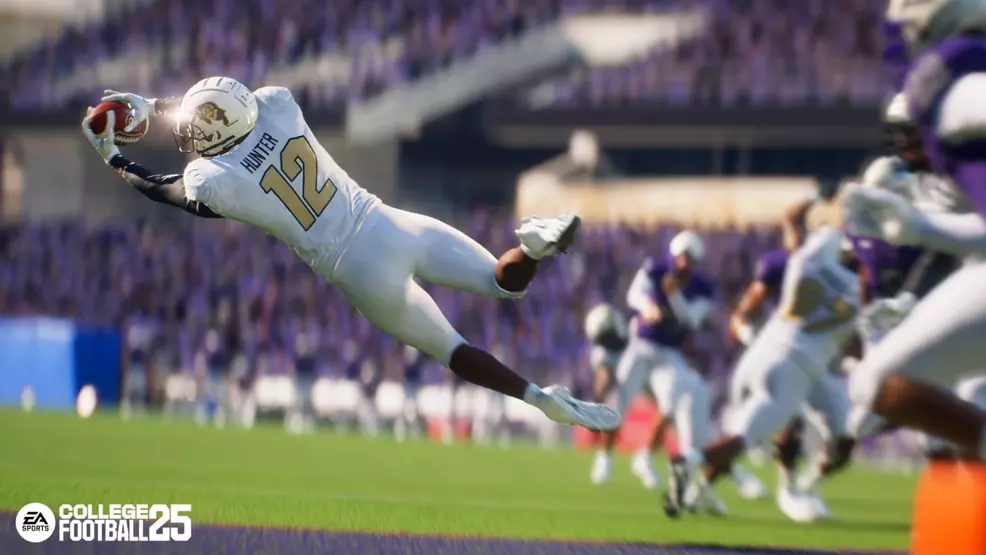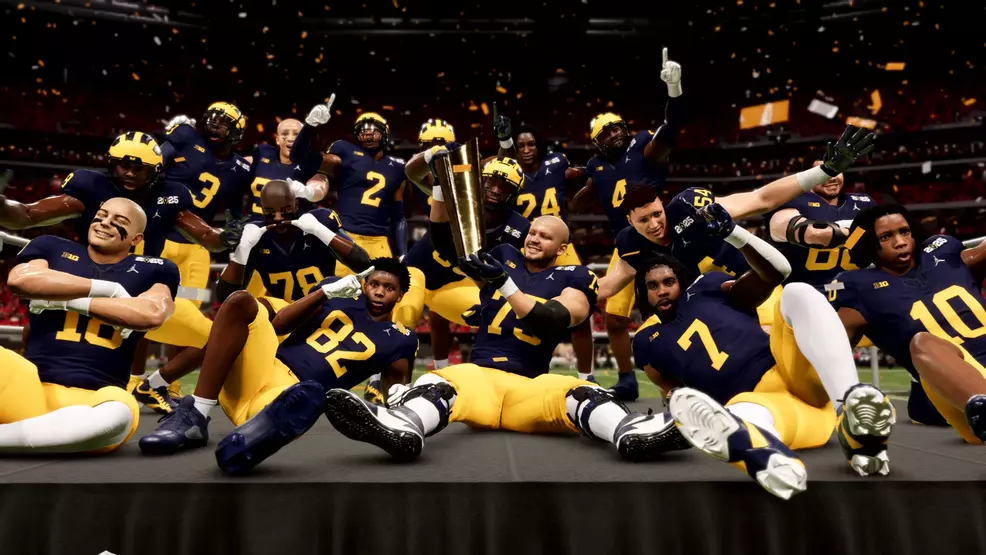Eleven years after the release of NCAA 14, the franchise has finally returned under a new name: EA Sports College Football 25. The long-awaited installment in the college football simulator series sees the return of Dynasty, Road to Glory, and Ultimate Team. Revamped mechanics, improved systems, and a variety of content make it a worthwhile return to college football.
New semester

Source: EA Sports
As a longtime player (and detractor) of the Madden series, I was initially worried that College Football 25 would essentially be a Madden game with college jerseys and stadiums; that this fabled return would be nothing more than a reskin of a franchise that’s been light on innovation and evolution for the better part of a decade. I couldn’t be happier to be wrong. College Football 25 feels like the perfect antidote for players who have grown tired of Madden.
CFB 25 has a more over-the-top arcade-like feel, which is fitting when you compare college football’s energetic and outlandish presentation to the buttoned-up NFL experience. Rules are less strict, so there are more opportunities for spectacular plays (tapping one foot in the endzone for a touchdown is chef’s kiss), and more freedom in play selection. The Option is a college staple, and EA does right by it with a deep library of plays that could honestly be an entire playbook. Improvements to pitching allow you to quickly shovel the ball to an HB at the sacrifice of power, or give them a strong pitch that takes longer to get out. Of course, I recognized a handful of animations from Madden, but not enough to take away from my experience.
One of EA’s big promises with CFB 25 was to capture the atmosphere of a college football game day. This includes all the pageantry and signature introductions that precede your typical match-up, especially when it comes to rivalry games. There’s an impressive amount of detail that goes into this, whether it be seeing Bevo in the tunnel at Darrell K Royal–Texas Memorial Stadium, or seeing the goofy Stanford Tree celebrating after a touchdown.

Source: EA Sports
The college atmosphere goes beyond aesthetics, as the return of Stadium Pulse means playing road games in hostile environments presents a genuine challenge. In one example, I was playing against Michigan on the road, and it was a one-score game in the fourth quarter. Not only was my screen shaking when I took the field, but I wasn’t able to audible because my players couldn’t verbally communicate over the crowd noise. The receiver routes were squiggled when I opened the play art, and the game kept showing me incorrect plays to throw me off. The stadium that you’re playing in, and your players’ ability to drown out the noise, can be the difference between a win and a loss.
One thing severely lacking in the atmosphere department is music. Outside of a couple of band tunes and drumlines, College Football 25 has only a handful of licensed songs with lyrics on its soundtrack, including Sandstorm by Darude and Sheck Wes’ Mo Bamba. They’re both songs that you’ll certainly hear during a timeout at a college football game, but alternating between just a few songs gets repetitive after a day of playing.
From a presentation standpoint, CFB 25 has a clean UI that’s easy to read and navigate quickly. In between plays, replays of the previous play shrink into a small window in the corner while you look at your playbook and receive a briefing on player stats, health, or the opponent’s last play call. It’s a neat little hub to have while in the huddle, though the transition in and out of it has a significantly reduced frame rate that was rough to watch at times.
All in the game

Source: EA Sports
College Football 25 also introduces Revamped Passing, which determines the arc and accuracy of a pass with a meter. Get it in the sweet spot to throw an accurate ball. Hold it too long and it’ll turn yellow or red, leading to more wild passes. Don’t hold it long enough, and your QB will lob the ball, which is good for tossing the ball over the head of a receiver. It takes some getting used to, as I threw plenty of interceptions to defenders sitting underneath a route while attempting to bullet pass, but it’s deeply satisfying once you learn how to place the ball in tight windows.
The new Wear & Tear system means that you’ll have to closely monitor and manage your players’ health over the course of a game (and season in Dynasty Mode). Wear & Tear is accumulated by playing consecutive downs and receiving physical contact. It’s displayed by a meter beneath the player’s model, and you can watch it deplete in real time. If a QB takes too many hits to his throwing arm, he’ll receive a temporary decrease to his Throwing Power and Throwing Accuracy stats. A running back that’s getting hit every play may see an increase in risk of injury. You have to keep an eye on which players are being worn down and make the appropriate substitutions to keep them healthy. It’s a game within the game, adding a new level of strategy as you’ll likely want to reserve your best players for the moments you need them most.
Big shoes to fill

Source: EA Sports
Dynasty Mode is back in a big way in EA Sports College Football 25. As a Head Coach, Offensive Coordinator, or Defensive Coordinator, it’s your job to take over a program and get them to a National Championship. This means luring players to your school through recruitment and building the ones on your roster.
You’re given a limited amount of Hours that can be used to interact with recruits, whether it be sending them a message, contacting their family, or just checking their social media. All of these activities can increase the chances that a player will commit to your school. You can also use these points to scout a player and learn more about their stats and abilities. In some cases, you’ll find a Gem, which is a player who can perform at a higher level than their star rating. Conversely, there are busts who aren’t as good as their rating makes them out to be.
Of course, you’re not the only school trying to court young talent, and you’ll have to compete with other programs across college football to secure commitments from recruits. Each week, you’ll see a player’s interest in a school increase (or decrease) based on the school’s interactions with them. Each player has their own preferences and priorities, such as wanting to play close to home, or wanting to attend a school that’ll offer brand exposure. If your school meets these requirements, you can go full steam ahead and offer them a scholarship (you can hand out 35 each season) and allocate your resources towards winning them over.

Source: EA Sports
Your school rating is based on the program’s recent performance and operation. When taking over East Carolina University, we had a lowly 1.5-star rating, so it was hard to secure blue chip players in my inaugural season. However, we performed over expectations, finishing 10-2 on the season. Our rating skyrocketed, and we began the following season at a 3-star rating. This time, several 4-star recruits had us in their top eight schools, and I was able to bring in more talent now that players saw us as a legitimate contender.
Building a team and watching players grow over time is awesome. As your coach increases their prowess, you’ll receive offers to join other universities in increased roles. I decided to stick with East Carolina and finish what I started. In my second season, we sent multiple players to the NFL, and I was rewarded with a lump sum of EXP for doing so. This also allowed me to unlock new skill trees and activate new abilities.
There’s more detail to Dynasty than initially presented, and I would’ve liked a more in-depth tutorial. The game doesn’t tell you that your Scouting Hours replenish at specific points in the season, or that inviting a player on a visit doesn’t count towards their individual Hour limit. I also would have appreciated an in-game explanation on Redshirts and how they should be used.
It's also noteworthy that create-a-prospect is no longer available in Dynasty mode. Instead, you must work with a pool of generated players every year. If you're someone who liked to freely customize their Dynasty roster in the old NCAA games, you'll be a bit disappointed by this.
Bring home the glory

Source: EA Sports
Road to the Glory is another series staple that makes its return in College Football 25. You start your career as a college freshman and work your way to earning a starting job by building Coach Trust and performing well when given the opportunity. Your player background and school will determine how hard it is for you to climb the depth chart and become a starter. Of course, playing well on game day is just a portion of what goes into being a college athlete.
In between games, you’ll set a weekly agenda where you spend energy to determine your players actions. Spending points on studying will improve your GPA (you must stay above a 2.0 to remain eligible), building leadership will increase coach trust faster, and extra training will expedite your progression at the cost of accumulating Wear & Tear. You’ll have to juggle these systems and choose your priorities wisely while working to make a name for yourself.
During the offseason, you can enter the transfer portal and see what offers you have from other schools. If you start your career at a smaller university that offers more playing time, an impressive performance could lead to offers from notable programs with higher brand exposure.
Road to Glory is a straightforward, enjoyable career mode. That said, it’s a bit of a bummer that you can’t begin your career in high school like in the old NCAA games.
Yesterday’s heroes

Source: EA Sports
NCAA 14 was released right before Ultimate Team became the cash cow (and number one priority) of the Madden games, so of course it makes its return in CFB 25. Now referred to as College Ultimate Team, it is more or less identical to the experience in Madden and other EA Sports games: build a roster of players across different teams and eras by opening packs, completing challenges, and buying cards at the Auction House. You can spend hours grinding for a small sum of coins to net yourself some decent players, or whip out the credit card and start swiping for those premium packs.
Ultimate Team is the only mode with microtransactions, and is clear that this is where EA wants players to be. At least it’s not as egregious as Madden, which sports full-screen advertisements for the latest Ultimate Team promotions every time you log in. What I will say is that it’s neat seeing current NFL players featured in Ultimate Team as their past college selves. In the decade without a CFB game, many college stars came and went without getting their due in a video game, so I liked seeing some of them get their time in the spotlight through Ultimate Team.
The Victors

Source: EA Sports
EA Sports College Football 25 succeeds at setting itself apart from Madden with new mechanics and systems that change the way you play the game. Wear & Tear forces a new kind of strategy, and the changes to passing and player movement open the door for unforgettable plays. There are some cracks in the presentation, the game needs more songs, and Dynasty could use a tad more polish, but College Football 25 has delivered a level of fun that I haven’t gotten from a football sim in years.
This review is based on the Deluxe Edition of EA Sports College Football 25 on Xbox Series X, which Shacknews purchased.
EA Sports College Football 25
- Wear & Tear system deepens gameplay strategy
- Dynasty Mode is a rich college football simulator
- Authentic recreation of team traditions
- Revamped Passing is rewarding once you learn it
- Ultimate Team is trite and uninventive
- Underwhelming soundtrack
- Some rough edges in presentation
-
Donovan Erskine posted a new article, EA Sports College Football 25 review: Homecoming
-
It's also noteworthy that create-a-prospect is no longer available in Dynasty mode. Instead, you must work with a pool of generated players every year. If you're someone who liked to freely customize their Dynasty roster in the old NCAA games, you'll be a bit disappointed by this.
I broke my spine for THIS!?! -


